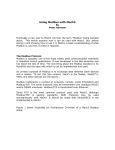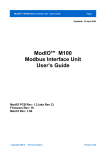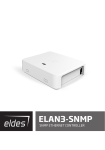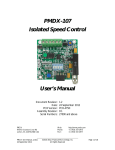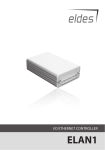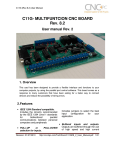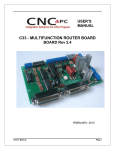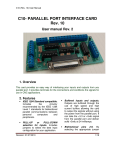Download DC-03 DigiSpeed GX v3.0 User Manual
Transcript
DigiSpeed DC-03 - Users Guide Page 1 Updated: 29. April 2009 DigiSpeed DC-03 Isolated Control Voltage Generator User’s Guide PCB: DC-03 V3.0 Firmware: Ver: 3.0 Mach3: Ver: 1.84 Copyright 2009 © Homann Designs Revision 0.3 DigiSpeed DC-03 - Users Guide Page 2 Homann Designs 20 View St HIGHETT VIC, 3190 AUSTRALIA [email protected] http://www.homanndesigns.com Copyright 2006-2009 © Homann Designs. All rights reserved. No part of this publication may be reproduced, transmitted, transcribed, stored in a retrieval system, or translated into any language or computer language, in any form or by any means, electronic, mechanical, magnetic, optical, chemical, manual or otherwise, without the prior written permission of Homann Designs. Disclaimer Homann Designs makes no representation or warranties with respect to the contents hereof and specifically disclaim any implied warranties or merchantability or fitness for any particular purpose. Information in this publication is subject to change without notice and does not represent a commitment on the part of Homann Designs. Feedback We appreciate any feedback you may have for improvements on this document. Please send your comments to [email protected] Trademarks DigiSpeed™ and DigiSpeed DC-03 are trademarks of Homann Designs. All other brand and product names mentioned herein are trademarks, services marks, registered trademarks, or registered service marks of their respective owners and should be treated as such. Copyright 2009 © Homann Designs Revision 0.3 DigiSpeed DC-03 - Users Guide Page 3 Table of Contents 1 Introduction.........................................................................................................................................................5 1.1 Contents......................................................................................................................................................5 1.2 Overview.....................................................................................................................................................6 2 Options...............................................................................................................................................................7 2.1 5Vdc – 15Vdc isolated DC-DC Converter..................................................................................................7 3 Features.............................................................................................................................................................8 4 Board Description...............................................................................................................................................9 4.1 Introduction.................................................................................................................................................9 4.2 Input Signal Polarity Jumper JP2.............................................................................................................10 4.3 Mode Indication LED.................................................................................................................................10 4.3.1 Mode Indication................................................................................................................................10 4.3.2 Input Activity Indication....................................................................................................................11 4.4 Output Attenuation Trimpot.......................................................................................................................11 4.5 Output Voltage Selection JP1...................................................................................................................11 4.6 Mode Selection Jumper Block JP3...........................................................................................................12 5 Quick Start Guide – PWM Mode......................................................................................................................13 5.1 What you need..........................................................................................................................................13 5.2 DigiSpeed DC-03 Setup...........................................................................................................................13 5.3 Mach3 Configuration Setup......................................................................................................................13 5.3.1 Port Setup........................................................................................................................................14 5.3.2 Spindle Setup Tab...........................................................................................................................14 5.3.3 Motor Outputs Setup........................................................................................................................15 5.3.4 Output Signals Setup.......................................................................................................................16 5.4 Power to the DigiSpeed-DC-03................................................................................................................16 5.5 Connect the PWM and Relay Signals......................................................................................................16 5.6 Conclusion................................................................................................................................................17 6 Installation........................................................................................................................................................17 6.1 DC Motor Speed Controller housing.........................................................................................................18 6.2 Wiring installation......................................................................................................................................18 6.2.1 Motor Controller Connection............................................................................................................18 6.2.2 Initial Testing....................................................................................................................................18 6.2.2.1 Attenuation Trimpot Speed Control.........................................................................................18 6.2.2.2 Computer Speed Control.........................................................................................................19 7 Operation..........................................................................................................................................................20 7.1 Operation Modes......................................................................................................................................20 7.1.1 Analog Input Mode...........................................................................................................................20 7.1.2 PWM Input Mode.............................................................................................................................20 7.1.3 Attenuation Trimpot.........................................................................................................................21 8 Board Dimensions............................................................................................................................................22 Copyright 2009 © Homann Designs Revision 0.3 DigiSpeed DC-03 - Users Guide Page 4 Index of Tables Table 1: Mode Select Jumper Block....................................................................................................................12 Table 2: DigiSpeed-DC-03™ - Breakout board Connections..............................................................................14 Table 3: Mode Selection Jumpers........................................................................................................................20 Illustration Index Illustration 1: Mach3 Port Setup...........................................................................................................................14 Illustration 2: Mach3 Spindle Setup Tab..............................................................................................................15 Illustration 3: Motor Outputs Setup Tab...............................................................................................................15 Illustration 4: Output Signals Setup Tab..............................................................................................................16 Illustration 5: PCB Dimensions and Layout..........................................................................................................22 Copyright 2009 © Homann Designs Revision 0.3 DigiSpeed DC-03 - Users Guide Page 5 *** WARNING *** The KB Electronics DC speed controller circuit, and other similar speed controllers as found in Asian imported mini lathes and mini mills are at mains voltage potential. This voltage is lethal. Do not attempt to do this conversion if you are not qualified to do so. Confidence is no replacement for qualification! If you feel that this project is beyond your abilities to SAFELY complete, we can install the unit for you. Please contact us for details Please ensure you read the complete manual before attempting to install or use this device. 1 Introduction Thank you for purchasing Homann Designs' DigiSpeed DC-03 Isolated Voltage interface unit. The DigiSpeed DC-03 provides a way for controlling DC motor speed controllers and other devices that accept a 0-5Vdc, 0-10Vdc, 0-15Vdc voltage signal This document is a User's Guide that describes the operation of the DigiSpeed DC-03. The document contains information on how to use and integrate the board into your own systems. 1.1 Contents The box received when ordering the DigiSpeed DC-03 contains the following: • • • DigiSpeed DC-03 isolated voltage interface unit. 4 x 0.1” jumpers. 4 x 4mm plastic PCB stand-offs. Copyright 2009 © Homann Designs Revision 0.3 DigiSpeed DC-03 - Users Guide 1.2 Page 6 Overview The DigiSpeed DC-03 Isolated Voltage Interface Unit is designed to allow devices such as the Gecko G-100 motion controller and computer CNC programs such as Mach2, TurboCNC and other CNC programs to control devices that require an isolated DC control voltage. DigiSpeed DC-03 is designed primarily for use with KB Electronics style DC motor controllers, such as the KBIC-120. This is the type of controller found in the Sherline Mills and Lathes. DigiSpeed DC-03 will work with other types of DC motor controllers such as those found in the Asian imported mini lathes and Mills. The DigiSpeed DC-03 is also well suited for use with VFDs such as the Automation Direct GS2 series and other motor speed controllers which accept a 0-5Vdc, 0-10Vdc speed control voltage. The form factor of the DigiSpeed DC-03 PCB has been designed for easy installation. Due to its compact size, it can also be installed unobtrusively into many of the existing speed controller or CNC controller enclosures. Copyright 2009 © Homann Designs Revision 0.3 DigiSpeed DC-03 - Users Guide Page 7 2 Options The DigiSpeed DC-03 is a versatile unit. It has an on-board LED indicator, mode select jumpers, and an attenuation multi-turn trim-pot The board is designed to be installed into existing motor speed controller housings, external CNC housings or other enclosures. 2.1 5Vdc – 15Vdc isolated DC-DC Converter. Depending on the installation, the device being controlled by the DigiSpeed DC-03 may not be able to provide the 10Vdc supply required by the isolated analog circuitry. In such situations, the optional On-board 5Vdc - 15Vdc isolated DC-DC converter may be used to provide the required supply. Note: The DigiSpeed DC-03 Attenuation trimpot may be used to scale the output voltage to 0-10Vdc, or to a voltage that is required by the device being controlled by the DigiSpeed DC-03 . Copyright 2009 © Homann Designs Revision 0.3 DigiSpeed DC-03 - Users Guide Page 8 3 Features The main features of the DigiSpeed DC-03 controller are; • • • • • • • • • • • • • • • • Controlled by a RISC Microchip micro-controller. PCB o FR4 Material o Double Sided, Plated through holes o Silk-Screened on Component Side o Solder Mask on Both Sides Small PCB footprint 5.5cm(L) x 4.5cm(W) Four 4mm mounting holes (supplied with matching stand-offs) Single 5V dc power requirements. Reverse polarity protection on 5V supply. Multi-Function status indicator LED Opto-isolation between the computer logic Voltages and the analolg output control voltages. Maximum DC Speed controller output voltage for the control supply of 15Vdc 10 bit resolution providing more than 1000 steps from 0 to Max Output voltage. Three methods to control motor speed. o 0-5V analog Voltage o PWM - A low frequency PWM signal. (2Hz – 100Hz ) o On-Board multi-turn trimpot Output Control Voltage Attenuator. SMT LED indicating the mode and state of the DigiSpeed DC-03 controller. 2 on board relays with leds for direction and enable/brake use. Jumper selectable Logic Hi or Logic low signals . Pluggable 3.5mm terminal block connectors for easy installation and maintenance. Copyright 2009 © Homann Designs Revision 0.3 DigiSpeed DC-03 - Users Guide Page 9 4 Board Description 4.1 Introduction The DigiSpeed DC-03 controller provides the capability to control a device such as the the spindle speed of a DC or AC motor via computer control May of the devices that the DigiSpeed DC-03 is designed to work with such as the KBIC-120 controller supplied by KB Electronics, use a “Hot Ground” circuitry. That is, the reference voltages for setting the speed are at MAINS POTENTIAL voltage. This voltage is dangerous and can be lethal. This style of controller uses a control voltage, usually in the 0 –10Vdc range to control the motor speed from 0 – max speed. In reality, this voltage can be anywhere in the range of 5Vdc to 15vdc. The maximum output voltage of the DigiSpeed DC-03 and thus the speed of the motor can be limited by an attenuation trim-pot that reduces this control voltage supply. AC motor controllers are usually Variable Frequency Drives (VFD) and have terminals for the connection of an external manual control potentiometer, or a 0-5Vdc, 0-10Vdc control voltage. The DigiSpeed DC-03 circuitry is essentially in two parts. One part contains low voltage logic level circuitry that includes a micro controller and interfaces to the PC or controlling device. It is supplied by 5Vdc that is referenced to the controlling devices ground. The other part of the DigiSpeed DC-03 circuitry is connected to the DC Speed controller control circuitry. This part is at MAINS POTENTIAL. The two parts of the circuitry are separated by opto-isolation. This ensures that the dangerous MAINS POTENTIAL voltages are kept away from the low level logic circuitry. The two parts of circuitry must never be connected together. If it happens, a catastrophic failure of the DigiSpeed DC-03 circuit and your PC will occur. The DC-03 also contains 2 small signal switching relays. These may be used for direction control, braking control or as an enable control for your motor speed controller. Copyright 2009 © Homann Designs Revision 0.3 DigiSpeed DC-03 - Users Guide Page 10 ***YOU HAVE BEEN WARNED*** DO NOT GROUND THE MAINS POTENTIAL SIDE OF THE CIRCUITRY The DigiSpeed DC-03 controller provides a control voltage in place of the control voltage provided by the manual speed control potentiometer. This voltage can be varied from 0V to 100% of the maximum control voltage by computer software. There are 1023 steps from 0 to the maximum control voltage. If your maximum spindle speed is 6000 rpm, this effectively provides for a 6-rpm resolution in controlling spindle speed. 4.2 Input Signal Polarity Jumper JP2 The DigiSpeed DC-03 has a jumper JP2 that allows you to select Logic Hi or Logic Lo inputs for the DigiSpeed-SD™. Logic Lo signals are where 0V on the input will turn on the relay. Logic Hi input require 5V to turn on the Relays. The jumper has two positions marked “^” (Logic Hi) and “v” (Logic Lo). 4.3 Mode Indication LED The DigiSpeed DC-03 controller contains a SMT LED that is used to indicate the input mode that has been selected and when activity on the input is present. 4.3.1 Mode Indication The DigiSpeed DC-03 controller used the status indicator LED to show which input mode is selected. It does this by flashing the LED on power up as described below; • LED Off – This indicates that there is no 5Vdc power supplied to the DigiSpeed DC-03 . • Single Flash – Indicates that the DigiSpeed DC-03 is powered in Analog input Mode. • Double Flash – Indicates that the DigiSpeed DC-03 is powered in PWM input Mode. • Triple Flash – Indicates that the DigiSpeed DC-03 is powered in Multi-turn Trimpot input Mode. Copyright 2009 © Homann Designs Revision 0.3 DigiSpeed DC-03 - Users Guide 4.3.2 Page 11 Input Activity Indication The DigiSpeed DC-03 controller uses the status indicator LED to indicate when there is activity on the input. This activity is as described below; 4.4 • LED Off – This indicates that there is no 5Vdc power supplied to the DigiSpeed DC-03 . • Lazy RED Double Flash – Indicates that the DigiSpeed DC-03 is powered on, and there is no activity on the input source. • Fast RED Flash – Indicates that the DigiSpeed DC-03 is powered, and there is activity on the input source. Output Attenuation Trimpot The DigiSpeed DC-03 controller contains an Output Attenuation Trimpot. The purpose of this is to attenuate or reduce the full scale output voltage of the controller. This may be used to reduce the maximum speed of a spindle. By turning the screw in the multi-turn trimpot VR1, in a Counter-Clockwise direction, the output voltage will be reduced, or attenuated. Some VFDs and motor controllers require a 0 – 5Vdc voltage to control spindle speed, yet provide a 10Vdc voltage supply. In this instance, the attenuator may be used to reduce the 10V control voltage to 5V as required by the controller. 4.5 Output Voltage Selection JP1 The DigiSpeed DC-03 controller contains an Output voltage selection jumper, JP1. The purpose of this is to select the source of the isolated voltage that is generated. If the jumper is fitted between pins 1-2 (towards the DC-DC generator) then the Generators 15Vdc voltage will be used. In this instance there is no need to connect the motor controller to pin AV+ on connector J2 If the jumper is fitted between pins 2-3 (away from the DC-DC generator) then the voltage supplied by the DC motor controller via connector J2, pin AV+ will be used. Copyright 2009 © Homann Designs Revision 0.3 DigiSpeed DC-03 - Users Guide 4.6 Page 12 Mode Selection Jumper Block JP3 The DigiSpeed DC-03 can operate in a number of modes, depending on the type of control signal that is provided by your CNC software and or controller. The mode is selected via the mode selection jumpers as shown in the picture below; Jumper JP3 consists of a two jumpers . If you orient the board so that the Blue input terminal block J1 is on the left, and the blue output terminal block J2 is on the right. Jumper block JP3 should be on the bottom left hand corner. MS1 and MS2 of JP3 are both oriented vertically. MS1 is to the left, MS2 to the right. Jumper Function Position MS1 Mode Select Left MS2 Mode Select Right Table 1: Mode Select Jumper Block Copyright 2009 © Homann Designs Revision 0.3 DigiSpeed DC-03 - Users Guide Page 13 5 Quick Start Guide – PWM Mode This section is intended to allow you to quickly setup and verify the operation of your DigiSpeed DC-03 controller with Mach3 for use in PWM mode. Initially, this will be done with the DigiSpeed DC-03 unit being connected to computer but not your Motor Drive. Once you are familiar with the operation of the DigiSpeedDC-03's operation, it can then be connected to the motor drive. The DigiSpeed DC-03 circuitry is essentially in two parts. One part contains low voltage logic level circuitry that includes a micro controller and interfaces to the PC via the parallel port. It is supplied by 5Vdc that is referenced to the PC parallel port ground. The other part of the DigiSpeed DC-03 circuitry is connected to the DC Speed controller control circuitry. This part is at MAINS POTENTIAL. The quick start setup will verify the connection to the Microprocessor and logic side of the DigiSpeed DC-03 controller. 5.1 What you need To get started, you need: • DigiSpeed DC-03 controller. • Breakout board or other mechanism for connecting the DigiSpeed DC-03 control lines to the Computer Printer port. • A PC with a printer port and Mach3 installed and running. This quick start setup is done with the DigiSpeed DC-03 unit sitting on the bench and NOT connected to your Motor controller. 5.2 DigiSpeed DC-03 Setup Mach3 controls the DigiSpeed DC-03 in PWM mode only. Therefore you need to place jumper MS1 into the mode selection jumper block JP3 JP1 controls where the voltage source for the analog output voltage comes from and is selectable between an on-board DC/DC converter (recommended) or Sourced externally via J2. 5.3 Mach3 Configuration Setup The example setup describes how Mach3 is configured for the DigiSpeed DC-03. Your configuration may differ depending on what Printer Port number you are using, and what pins in the port are connected to which DigiSpeed DC-03 pins. For this example, printer port 2 is being used with the port pins connected as shown in . Notes: 1. It is advisable to use a breakout board between the Printer port and the DigiSpeed DC-03. 2. The 5V supply for the DigiSpeed DC-03 must be obtained from the breakout board, as it cannot be supplied from the printer port. Copyright 2009 © Homann Designs Revision 0.3 DigiSpeed DC-03 - Users Guide Signal Page 14 Printer Port Pin Number PC Input/Ou tput DigiSpeedDC-03 J1 Pins PC Parallel Port GND (0V) 18-25 - GND PWM 1 Out PWM Relay 1 (Spindle Dir) 17 Out Relay 1 Relay 2 (CW/CCW Enable) 16 Out Relay 2 5Vdc power - - +5V Analog Input. - - Ana Table 2: DigiSpeed-DC-03™ - Breakout board Connections 5.3.1 Port Setup From the Options menu in Mach3, select the Ports & Pins Setup item. As shown in Illustration 1 below, Port 2 is enabled and is set to the default printer port address 0X378. The other items on this page are not concerned with the DigiSpeed DC-03 Setup. Illustration 1: Mach3 Port Setup 5.3.2 Spindle Setup Tab The Spindle setup tab is used to configure various option regarding the Spindle operation. As shown in Illustration 2 below, the following items are configured: • • Motor Control – As shown below, the following items are setup: • The Use 'Spindle Motor Output' check box is ticked. • The 'PWM Control' check box is ticked. • The PWM base frequency is set to 50. • The minimum PWM % is set to 0 Pulley ratios – The maximum spindle speeds for the pulley ratios you have are set up to allow Mach3 to calculate the required PWM percentage. Copyright 2009 © Homann Designs Revision 0.3 DigiSpeed DC-03 - Users Guide Page 15 Illustration 2: Mach3 Spindle Setup Tab This now concludes the configuration of the Mach3 software for the DigiSpeed DC-03. The next step is to hook up the unit to your breakout board for testing. 5.3.3 Motor Outputs Setup Select the Motor Outputs tab and enable the Spindle Axis. Set the Port and Pin numbers that will be used for the DigiSpeed-03 Step and Dir lines. As can be seen in Illustration 3 , The DC-03 Sig input is set to the spindle step pin has been set to 17, with the DC-03 RL1 input connected to the Dir signal set to 1. The port number for both of these pins has been set to Port 1 in line with the previous port setup. Active Low signals are not selected Illustration 3: Motor Outputs Setup Tab for both of these pins, as the DigiSpeed-03 is conigured via JP1 to operate with Active Hi Logic. It is possible to use JP2 to select Active Lo logic if desired.. Note: If you are not planning to run the spindle in reverse (Most installations) you do not need to connect the Spindle Dir pin. Just set the pin number to 0. This uses one less printer port pin that may be used for other functions. Copyright 2009 © Homann Designs Revision 0.3 DigiSpeed DC-03 - Users Guide 5.3.4 Page 16 Output Signals Setup Select the Signal Outputs tab and enable the Enable1 output. Set the Port and Pin numbers that will be used for the DigiSpeed-03 Step and Dir lines. As can be seen in below, the DC-03 RL2 input signal is set to the Enable1 pin has been set to 16, the Dir signal set to 1. The port number for both of these pins has been set to Port 1 in line with the previous port setup. Active Low signals are not selected Illustration 4: Output Signals Setup Tab for both of these pins, as the DigiSpeed-03 is conigured via JP1 to operate with Active Hi Logic. It is possible to use JP2 to select Active Lo logic if desired. Note: If you are not planning to run the spindle in reverse (Most installations) you do not need to connect the Spindle Dir pin. Just set the pin number to 0. This uses one less printer port pin that may be used for other functions. 5.4 Power to the DigiSpeed-DC-03 The first step in the installation is to provide 5V power to the DigiSpeed DC-03 controller. Wire DigiSpeed DC-03 J1- GND pin to a logic ground terminal on your CNC controller breakout board. This logic ground is the same as the PC printer port 0V potential, found on pins 18 to 25 of your printer port. Wire DigiSpeed DC-03 J1-+5V to a 5Vdc supply on your CNC controller's breakout board. This needs to be 5Vdc with respect to the PC printer port ground. Turn on your CNC controller. This should provide the 5Vdc supply to the DigiSpeed DC-03. Verify this is the case, by checking that the Mode Indicator LED is flash a slow double flash. If not, turn off the CNC controller and check the wiring. 5.5 Connect the PWM and Relay Signals Wire DigiSpeed-03 J1-Sig to pin 17 of the printer port via your CNC controller's breakout board. If you plan to use the relays on the DigiSpeed-03 board then they will need to be wired to your breakout board. If you are not using them, they do not need to be connected. Wire DigiSpeed-03 J1-RL1 (Dir) to pin 1 of the printer port via your CNC controller's breakout board. Copyright 2009 © Homann Designs Revision 0.3 DigiSpeed DC-03 - Users Guide Page 17 Wire DigiSpeed-03 J1-RL2 (CW/CCW Enable) to pin 16 of the printer port via your CNC controller's breakout board. If you have wired up the relay control signals you can now test that the signals are being received by the DigiSpeed-03. Set the spindle speed to zero typing it into the speed DRO, or entering the command 'S 0' into the MDI window . Now enter a spindle speed of 1000 into the DRO and enable the spindle. You should now observe the DigiSpeed DC-03 Mode Indicator LED perform a continuous Red fast flash. This indicates that the DigiSpeed DC-03 is enabled and is generating an analog control voltage on the output. Now using the MDI window, enter 'M3' (Enable spindle CW) . Relay 1 should stay off, and Relay 2 (enable) should turn on. Now type in 'M4' (Enable Spindle CCW) , Relay 2 (Enable) should go off, then Relay 1 should turn on (CCW) and Relay 2 (Enable) should turn back on. Now type in 'M5' (Spindle Stop), Relay 2 should turn off. If the relays appear to work in reverse, it may be that the Logic direction jumper is incorrect. You can change the sense of the logic inputs, Step, Relay 1, and Relay 2 by changing the position of jumper JP2. 5.6 Conclusion You should now have your DigiSpeed DC-03 operating correctly with Mach3. You are now ready to install the unit into your Motor Speed controller's enclosure, your CNC controller or a separate enclosure. 6 Installation Before attempting the installation please read the entire manual. If you are unsure of anything, do not do the installation. Get help from someone who is qualified for this type of work. I am not responsible for damage or injury resulting from the installation or use of this device. It is advisable to integrate the The DigiSpeed DC-03 with your control software before installing and connecting it to your Motor Controller. The unit is powered from a breakout board. Therefore it is possible to test and become familiar with it's operation prior to connecting it to a motor controller. The board has indicator LEDs that provide status of what is occurring. These can be used to assist in the integration. The DigiSpeed DC-03 may be mounted into an existing motor controller enclosure or external enclosures. The hardware installation is dependent on what you are installing the DigiSpeed DC-03 into. The physical installation is first covered in the section below, followed by the electrical installation. Copyright 2009 © Homann Designs Revision 0.3 DigiSpeed DC-03 - Users Guide 6.1 Page 18 DC Motor Speed Controller housing If the DigiSpeed DC-03 is to be installed into an existing Motor speed controller housing, ensure that there is sufficient space to safely install the DigiSpeed DC-03. Refer to the PCB layout and dimensions diagram in determining the positions of holes for mounting. The unit may be mounted using the 4 stand-offs provided. 6.2 Wiring installation Once the DigiSpeed DC-03 controller is installed into a housing the following wiring is required. 6.2.1 Motor Controller Connection The DigiSpeed DC-03 is connected to the motor controller via the three terminal pluggable connector J2. • • • The terminal labeled AV+ connects to the potentiometer positive voltage connector on the speed controller. The terminal labeled Vout connects to the potentiometer connector on the speed controller. The terminal labeled AGnd connects to the potentiometer control voltage on the speed controller. These three connections plug into your speed controller in place of your existing manual speed potentiometer. Unless you are using a voltage isolation board these leads are at ***MAINS VOLTAGE POTENTIAL ***. They can cause serious injury or death. Do not connect any earthed test equipment to this terminal block as it is at mains potential. 6.2.2 Initial Testing 6.2.2.1 Attenuation Trimpot Speed Control. To test the DigiSpeed DC-03 control manually via the attenuation trimpot VR1: 1. Turn off the Motor Speed controller and the CNC controller . 2. Set the DigiSpeed DC-03 mode to Attenuation Trimpot by inserting jumpers MS1 and MS2. 3. Turn the attenuation trimpot Anti-Clockwise eleven complete turns. 4. Power up the DigiSpeed DC-03 . 5. Turn on the Motor Speed controller. Ensure that there is 5Vdc power applied to the DigiSpeed DC-03. You can verify this by the Lazy Double Flash of the LED illuminated on the DigiSpeed DC-03. 6. Slowly turn the trimpot Clockwise unit the required maximum spindle speed is reached. Copyright 2009 © Homann Designs Revision 0.3 DigiSpeed DC-03 - Users Guide 6.2.2.2 Page 19 Computer Speed Control. To test the DigiSpeed DC-03 control from Mach3: 1. Turn off the Motor Speed controller and the CNC controller . 2. Set the DigiSpeed DC-03 mode to :PWM by inserting jumpers MS1 only. 3. Power up the DigiSpeed DC-03 . 4. Turn on the Motor Speed controller. Ensure that there is 5Vdc power applied to the DigiSpeed DC-03. You can verify this by the Lazy Double Flash of the LED illuminated on the DigiSpeed DC-03. Run through the tests detailed in the Quick Start Guide section with the understanding that the spindle is not powered and operational. Copyright 2009 © Homann Designs Revision 0.3 DigiSpeed DC-03 - Users Guide Page 20 7 Operation 7.1 Operation Modes The DigiSpeed DC-03 has three operational modes, selected by jumpers MS1, MS2 in jumper block JP2. The selection of the modes is described below. Mode MS1 MS2 ANALOG Removed Don't Care PWM Installed Removed Attenuation Trimpot Installed Installed Table 3: Mode Selection Jumpers The selection of the mode is done at power up initialization. Note: If the mode selection jumpers are modified after the unit is powered up, the new mode will not take effect until the power is cycled. Each of the modes is discussed in detail below. 7.1.1 Analog Input Mode In this mode the DigiSpeed DC-03 controller accepts an analog 0-5Vdc signal. 0Vdc represents 0%, varying to 5Vdc which represents 100% of maximum spindle speed. This will provide 1023 speed increments from 0 to 100% of maximum spindle speed. With the DigiSpeed DC-03 module supplied with power, and no analog signal is present, the LED will be a Red slow double flash. This indicates that the spindle is active but the speed is set to 0 %. Then, when an analog voltage signal is present, the LED will be a fast continuous flash, indicating that the spindle is active and the speed is set to a value greater than 0 %. 7.1.2 PWM Input Mode In this mode the DigiSpeed DC-03 controller accepts an “Active Low” Pulse Width Modulation signal. The duty cycle of this signal represents 0 to 100% of maximum spindle speed. The PWM signal period can be in the range of 2Hz to 50Hz. The optimum period is 50Hz. This will provide 1023 speed increments from 0 to 100% of maximum spindle speed. Copyright 2009 © Homann Designs Revision 0.3 DigiSpeed DC-03 - Users Guide Page 21 With +5V is supplied to the DigiSpeed DC-03 module, and no PWM signal is present, the LED will be a Red slow double flash. This indicates that the spindle is active but the speed is set to 0 %. Then, when a PWM signal is present, the LED will be a fast continuous flash, indicating that the spindle is active and the speed is set to a value greater than 0 %. 7.1.3 Attenuation Trimpot In this mode the DigiSpeed DC-03 controller uses the attenuation trimpot to generate the oiutput voltage. It assumes there is a fullscale analog voltage input and then attenuates it to produce 0% to 100% of the output voltage. With +5V is supplied to the DigiSpeed DC-03 module, the LED will be a slow double flash when the trimpot is set to maximum attenuation by turning the screw fully counter-clockwise.. When the attenuation is not set at maximum, the LED will flash at a fast rate, with the output voltage generated as a percentage of the full scale voltage. Copyright 2009 © Homann Designs Revision 0.3 DigiSpeed DC-03 - Users Guide Page 22 8 Board Dimensions Illustration 5: PCB Dimensions and Layout Copyright 2009 © Homann Designs Revision 0.3























